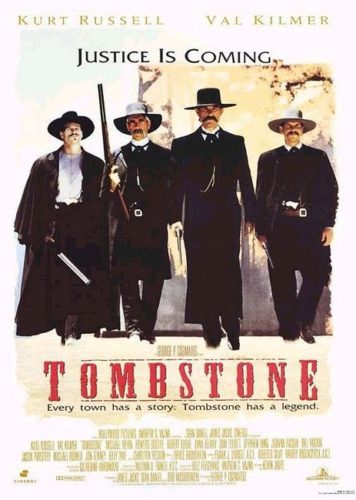
Not Quite Horror contains reviews of films not traditionally considered horror films. By analyzing them as horror films (identifying the monster, discussing the shared worry for the audience and the main characters, and understanding the depth of horror available to the viewer), who knows? There more than one way to watch a movie.
The Monster: Johnny Ringo may have been a real man, but the Johnny Ringo character in Tombstone (played by Michael Biehn) is more demon than man. To begin with, he’s played by a well-respected horror actor. He sports a satanic goatee. Early in the movie, he guns down preacher without a second of hesitation. Later in the film, he even confesses to having made a deal with the devil and screams that he wants his enemies’ blood.
The Shared Fate: Ringo is an exaggerated representation of violent, relentless people who make headlines for all the wrong reasons. When heroic Wyatt Earp (Kurt Russell) is drawn closer and closer to a confrontation with Johnny Ringo, he echoes the audiences’ own worries about being victimized by violent people when he laments, “I can’t beat him, can I?â€
Interestingly, he voices this doubt even after he himself has become tainted by the evil of violence, declaring he was bringing the forces of Hell with him in his quest for revenge on Johnny Ringo and his gang.
The Horror: Tombstone’s extended running time (over two hours) and large assortment of characters drain the suspense and terror from Johnny Ringo’s relentless thirst for death. Edited to focus on the confrontation between Ringo and Earp (and Earp’s friend Doc Holliday, played by Val Kilmer), the film could have been billed as a thriller instead of a western.
Even while hidden in the grand scenery and historical subplots, the unstoppable violence of Ringo’s gun is more than enough villain to make the hero demonstrate his bravery. With the less-than-subtle insinuations Ringo might be supernaturally possessed by an actual demonic evil, it doesn’t take much imagination to picture how much further this gunslinger could’ve taken his fury.
— I am indebted to Noel Carroll’s The Philosophy of Horror for his ideas on defining horror, as well as John Skipp and Craig Spector’s article “Death’s Rich Pageantry, or Skipp & Spector’s Handy-Dandy Splatterpunk Guide to the Horrors of Non-horror Film†in Cut! Horror Writers on Horror Film for a similar idea.–
–Axel Kohagen
